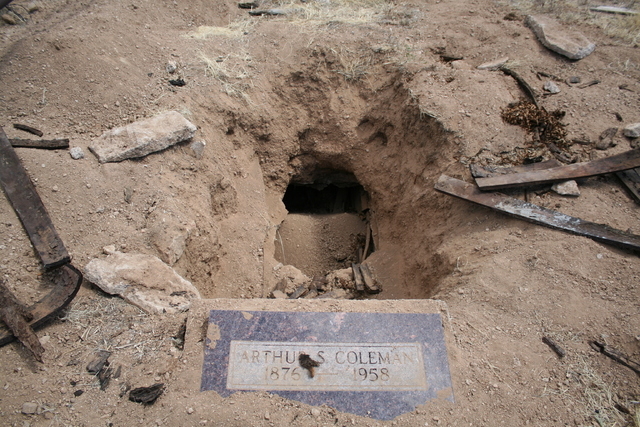Coroner examining Gold Butte bones

Bones found at an old Gold Butte grave site that was disturbed recently are in the hands of the Clark County coroner’s office.
Coroner Mike Murphy said the bones were collected last week and brought to Las Vegas, where they will be examined to determine whether they came from the grave of a prospector who lived and died more than 50 years ago at the long-abandoned mining camp in northeastern Clark County.
“We are responsible for people who are deceased,” Murphy said. “That’s the responsibility we have, and we take that very seriously.”
The bones were found around a dug-up grave marked for Arthur Coleman, who died in 1958 at age 82 and was buried in the remote desert behind a house he shared for decades with his business partner and friend, William Garrett.
When Garrett died in 1961 at age 81, he was buried next to Coleman. Years later, their plots were fenced and marked with engraved headstones as part of an Eagle Scout project.
Sometime in the past few weeks, someone dug into the grave marked for Coleman, leaving a deep hole surrounded by pieces of wood, possibly from a coffin. Pictures of the damage supplied to the Review-Journal also show other debris, some of which could be bone.
Murphy said officials from his office and the Metropolitan Police Department traveled to the site about 100 miles from Las Vegas to collect the bones early on April 23, the day after the damage was reported to authorities.
Medical examiners will first try to determine whether the bones are human and how old they might be. Murphy said determining the approximate age of the bones and the gender of the person they belonged to could be enough circumstantial evidence to close the case and re-inter the remains at Gold Butte.
The process could take as little as a month or two, or it could take considerably longer if DNA analysis is needed, Murphy said. The case is not considered active, so other, more pressing investigations will be handled first.
A related mystery could make it more difficult to return the bones to their proper resting place, according to two local history buffs and advocates for the protection of the Gold Butte area.
Terri Robertson and John Lear both said a sonar study conducted several years ago cast some doubt on whether the headstones for Coleman and Garrett were placed on the right graves. Those who knew the two men nicknamed them “the long and the short of it” because Garrett was 6-foot-1 and Coleman was 5-foot-1, but in the sonar images, the body in Coleman’s grave looked taller than the body in Garrett’s grave, Robertson and Lear said.
The men’s graves — and the remains of the old town site where they ran cattle, brewed moonshine and hunted for gold long after Gold Butte faded away — are in an nearly 600,000-acre area federal authorities closed early last month to round up cattle belonging to rancher Cliven Bundy. It’s unclear if the burial site was disturbed while the land was closed or after federal authorities hastily released the cattle they had collected and retreated from the area on April 12.
Mark Boatwright, an archaeologist for the U.S. Bureau of Land Management in Southern Nevada, said last week that whoever dug up the grave could face a felony charge under the federal Archaeological Resources Protection Act of 1979, which carries penalties of as much as a year in prison and a $10,000 fine. And they could face prosecution under state laws against disturbing burial sites, he said.
Murphy isn’t jumping to conclusions, however. He said his office has a responsibility to determine whose bones were found, how that person died and where the remains belong.
“We don’t believe at this point that this is a fresh case,” he said. “But I think we have to be very cautious about that.”
Contact Henry Brean at hbrean@reviewjournal.com or 702-383-0350. Find him on Twitter: @RefriedBrean.